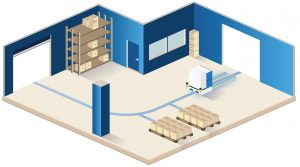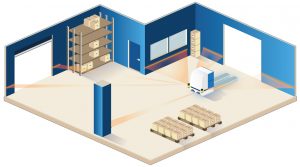3 Mistakes to Avoid When Investing In AGV Technology
Guest blog by Dr. Nicola Tomatis from MHI Member Company BlueBotics
Automated guided vehicles (AGVs) can offer a lot of benefits in terms of increased efficiency, enhanced worker safety, and reduced material handling costs, but there are some pitfalls that you should avoid when you embark on your journey into AGV technology.
1. Don’t try to automate a manual process ‘as is’
The first thing to think about when automating a manual process, no matter if it is with AGVs or other technologies, is that it is a journey, not a small step. Very often, a human driven, manual process can simply not be automated ‘as is’; it needs to be analyzed, simplified, and standardized before automating. AGVs or other robots can only do as they are programmed. While some systems offer incredible flexibility and configurability, manual processes need to be reevaluated with automation steps in mind to ensure a smooth transition and optimized efficiency.
2. Not all navigation systems are the same
It may seem an obvious statement but there are several key differences in AGV navigation technology that you should understand to ensure you select a vehicle that truly suits your application.
For example, AGVs that follow a physical line on the floor (a.k.a. line following), based on inductive wires or magnetic tape, are simple to understand and operate, and highly accurate. However, they have constraints in terms of flexibility: their installation can be relatively burdensome in terms of time and cost; these installations will not be easy or quick to modify; and these systems are very limited when it comes to operating a fleet and running traffic management.
If the process you are looking to automate is simple, such as a loop production line, then a line following AGV may be perfectly adequate. But if the process is more complex, or is likely to require regular modification to adapt to an evolving site, then other technologies offer a better solution. Laser triangulation is one approach, but this requires significant site installation time and therefore cost. For ultimate flexibility and adaptability, natural feature navigation will provide you with lower installation costs, be easier to update in future, and offer efficient, intelligent fleet and traffic management options.
3. Don’t assume robustness and accuracy
In recent years there has been an explosion in the number of AGV suppliers. Most focus on simplifying the installation of vehicles and flexibility, which is, as noted above, important. However, a significant portion of these new arrivals fail in terms of robustness and accuracy. What does this mean for your investment?
As well as providing a reliable, cost-effective solution, material handling applications usually require a good level of both accuracy and flexibility. If a system lacks robustness, your return on investment in AGV technology may be lost because of reduced system availability and maintenance overheads. If its level of positioning accuracy is below average meanwhile, some basic applications may still work but many typical production or logistics applications will simply not be feasible or, at best, be problematic in practice. If, for example, your application requires the picking and dropping of payloads, or an AGV moving under racks to pick these up, the high positioning accuracy of your vehicle will be vital. In order to make use of automatic charging stations, your AGV will also need a certain level of accuracy to dock correctly. Otherwise, you will need to install an additional line following system or fixed conveyor equipment to achieve the accuracy required. When it comes to guaranteeing accuracy, a vehicle’s positioning and navigation system is again pivotal, making this arguably the most crucial single technology choice to ensure the successful automation of your mobile processes.







